
Feature Article
Glycidyl Esters in Edible Fats and Oils and Infant Formula
In recent years, overseas studies revealed that glycidyl esters (GEs) were found in foods containing refined vegetable fats and oils, including margarine, bakery and pastry products, deep-fried products, various snack products, as well as infant formula and follow-up formula.
GEs Is an Emerging Food Safety Issue
GEs are process contaminants formed mainly during deodorisation in the refining of vegetable oils. After ingestion, GEs are broken down in the human body to release glycidol.
Glycidol is a genotoxic carcinogen classified as a group 2A agent (i.e. probably carcinogenic to humans) by the International Agency for Research on Cancer based on sufficient evidence in experimental animals. It may also have toxic effects on the nervous, renal and reproductive systems in experimental animals.
Risk Assessment Study
To examine the GE levels in fats and oils as well as infant formula available in the local market, the Centre for Food Safety (CFS) completed a risk assessment study on GEs in edible fats and oils and infant formula in July 2020.
A total of 207 samples, including 169 samples of edible fats and oils (covering palm oil, canola oil, corn oil, peanut oil, soybean oil, sunflower oil, other vegetable oils, butter, lard, margarine, spread and shortening) and 38 samples of infant formula, were tested for GEs.
Results of the study showed that the GE levels in edible fats and oils ranged from 16 µg/kg to 4,500 µg/kg*, with a mean level of 569 µg/kg. As for infant formula, the GE level detected ranged from 3.1 µg/kg to 53 µg/kg, with a mean level of 10.6 µg/ kg.
International Comparison
The mean GE levels in both the edible fats and oils samples and infant formula samples collected in the study were lower than the findings of similar studies by the European Food Safety Authority as well as New Zealand Food Safety and Food Standards Australia New Zealand. In addition, the upper ends of the range of GE levels in both the edible fats and oils samples and infant formula samples collected in the study were lower compared with the other two studies.
Further Findings
Reduction of GEs in refined oils and their products is possible when traders enhance their awareness on the issue and adopt relevant mitigation measures. A decreasing trend of GE levels in these foods is expected when food safety authorities and food traders worldwide develop an increased awareness of GEs following the recommendations of the Codex Alimentarius Commission (Codex) released in 2019.
In fact, a signal of decrement on the GE levels in foods was observed when some locally available follow-up oil samples were retested in 2020. It showed a reduction of more than 40% in most samples compared with the GE levels of the same products collected from late 2018 to early 2019.
Advice to Trade
The food trade is advised to take measures to minimise the GE levels in food products by referring to the ALARA (As Low As Reasonably Achievable) principle and the relevant code of practice adopted by the Codex in 2019.
* Unless otherwise specified, the GE levels listed are upper bound values.
Readers' Corner
Food Safety Tips for Frozen Meat
In recent years, there has been a growing demand for frozen foods (e.g. frozen meats and poultry) in Hong Kong. A reason for that is the longer shelf life of frozen foods allows them to be stored in a freezer for later use. The following are some tips to ensure the food safety of frozen meat.
How Is Frozen Meat Regulated in Hong Kong?
In Hong Kong, frozen meat mainly comes from Brazil, the Mainland, the USA, Canada and the Netherlands. There are specific legal requirements for the import of meats, including frozen meat.
Regulation 4(1)(a) of the Imported Game, Meat, Poultry and Eggs Regulations (Cap. 132AK) requires meat or poultry to be imported with a health certificate issued by an issuing entity recognised by the Director of Food and Environmental Hygiene. Under the Import and Export Ordinance (Cap. 60), the import of meat and poultry is subject to import licensing control. The Food and Environmental Hygiene Department is responsible for issuing import licences for these foods.
Moreover, importers are required to source meats from reliable suppliers, obtain health certificates, apply for import licences and ensure that the meats are fit for human consumption.
Apart from import control, frozen meat is also subject to routine surveillance and testing at the import, wholesale and retail levels like other foods available for sale on the market.
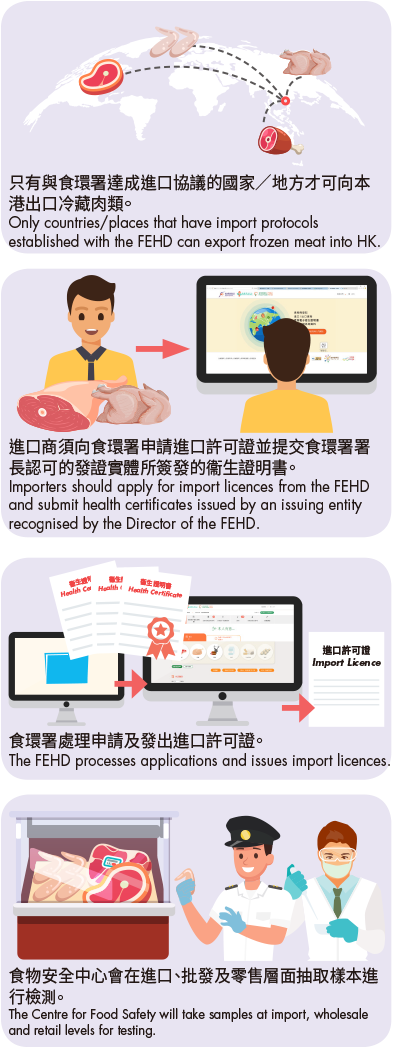
Figure 1: Regulatory regime for frozen meat
Points to Note When Buying and Storing Frozen Meat
Consumers should patronise hygienic shops that display frozen meat for sale in the freezer cabinet at -18°C or below, a temperature effective in inhibiting bacterial growth. For prepackaged frozen meat, it is necessary to check the expiry date. If you are buying non-prepacked frozen meat, make sure that it is ice-hard and its surface is dry.
Frozen foods stored continuously at -18°C or below can be kept safe for a long time. However, their quality may begin to decline after three to six months. Frozen meat not intended for immediate use should be placed in a freezer as soon as possible after purchase. It is advisable to follow the manufacturer’s storage instructions and consume the products before the expiry date. Non-prepacked frozen meat should be wrapped in cling film, put into plastic bags and marked with the date of purchase. Use frozen foods according to the “first-in, first-out” rule.
Thawing Frozen Meat
Freezing cannot kill bacteria. It is also not appropriate to leave frozen meat at room temperature or in hot water for thawing. As soon as frozen meat becomes warmer than 4°C, the bacteria present in the food prior to freezing can become active and start to multiply. Therefore, frozen meat should be thawed in a refrigerator at 0°C to 4°C. To avoid cross-contamination, the meat should be kept in a leakproof container or a leakproof package to prevent dripping of the meat juice onto ready-to-eat food. For fast thawing, frozen meat can be defrosted under cold running water or in a microwave oven. However, these two methods have the implication of leaving the meat or part of the meat in the temperature danger zone (i.e. 4°C to 60°C) that favours bacterial growth. Hence, frozen meat thawed in cold water or by microwave has to be cooked immediately.
Frozen Meat Should Always Be Cooked Thoroughly
Meat should be cooked thoroughly with its core temperature reaching 75°C or above. Although it is safe to cook food (including frozen meat, especially small or thin cuts) without thawing, food must be thoroughly cooked before consumption. Some food items like frozen chicken nuggets and frozen dumplings can be cooked without thawing. However, direct cooking of unthawed meat in a slow cooker is not recommended because it may put the meat in the temperature danger zone for too long, which allows rapid growth of harmful bacteria.
Refreezing: To Do or Not to Do?
Refreezing of thawed or partially thawed food is not recommended, unless the food has been properly defrosted in the refrigerator and consistently kept below 4°C to retard bacterial growth. Refreezing of properly thawed food may reduce its quality, but the food will be safe for consumption when it is thoroughly cooked.
Key Points to Note
-
In Hong Kong, import control and routine surveillance are in place for meat and meat products, including frozen meat.
- Meat kept properly in the freezer at or under -18°C has an extended shelf life.
-
Frozen meat should be thawed and cooked at proper temperatures to ensure food safety.
Advice to Trade
- Importers are required to source meat or meat products from reliable suppliers and obtain health certificates issued by relevant eligible exporting countries.
- Take note of the new arrangement (including eligible establishments and updated health certificates) for the import of Brazilian meat, poultry and eggs into Hong Kong.
- Maintain good temperature control during receiving, processing, storage, transport, distribution and retailing of frozen meat.
Health Advice for Frozen Food Handlers on the Prevention of COVID-19
In view of the detection and isolation of live SARS-CoV-2 coronavirus from the outer packaging of imported frozen foods in Mainland China, people frequently handling frozen food should be alert of the relevant risk of infection. The CFS has drawn up a list of Health Advice for Frozen Food Handlers on the Prevention of COVID-19 and recommended frozen food handlers to adopt the following measures:
- Practise good personal hygiene, such as washing hands with liquid soap and water and rubbing hands for at least 20 seconds before and after handling food, and after cleansing, handling refuse and visiting the toilet.
- Check the body temperature daily before working. If you are suffering or suspected to be suffering from an infectious disease or have developed symptoms of an illness, you should stop working, wear a surgical mask and seek medical advice promptly.
- When on duty, put on a surgical mask, eye protective equipment (e.g. a face shield), gloves and a gown.
- Ensure that the work environment is adequately ventilated and the drainage system is functioning properly.
- Step up cleansing of the work environment and maintain regular disinfection by applying 1:99 diluted household bleach. Besides, quaternary ammonium compounds can be used for effective decontamination of food contact surfaces, containers and food trays. Cleaning surfaces with alcohol-based disinfectants (ethanol, propan-2-ol, propan-1-ol) at concentrations of 70-80% with one-minute exposure time can also significantly reduce the infectivity of the SARS-CoV-2 coronavirus.
- While it is most important for food handlers to maintain hand hygiene, the disinfectants suggested above may be used to disinfect food packing surfaces if needed.
- Ensure adequate social distancing at the workplace, such as rearranging the workflow or assigning staggered working hours and flexible mealtimes to minimise direct face-to-face encounters among the staff.
The related health advice has been uploaded to the CFS website (www.cfs.gov.hk/covid19). Food traders are advised to read it carefully and share the information with frozen food handlers. They should also facilitate employees suffering from an infectious disease or with symptoms of an illness to seek medical treatment promptly, including the testing for COVID-19 if necessary.
Spot Check
Join Efforts to Uphold Food Safety of Food Delivery
Background
Amid the on-going COVID-19 epidemic, food delivery from food premises is becoming more popular. With the advance of mobile applications and technology, food orders can be easily made at our fingertips. However, there are many steps in food handling from the kitchen to the customers’ table. This raises public concern about the food safety risks involved in the food delivery service, including the lack of suitable temperature control and the risk of cross-contamination throughout the delivery process. It is necessary for food operators, delivery staff and customers to join hands to ensure that the delivered food is safe for consumption.
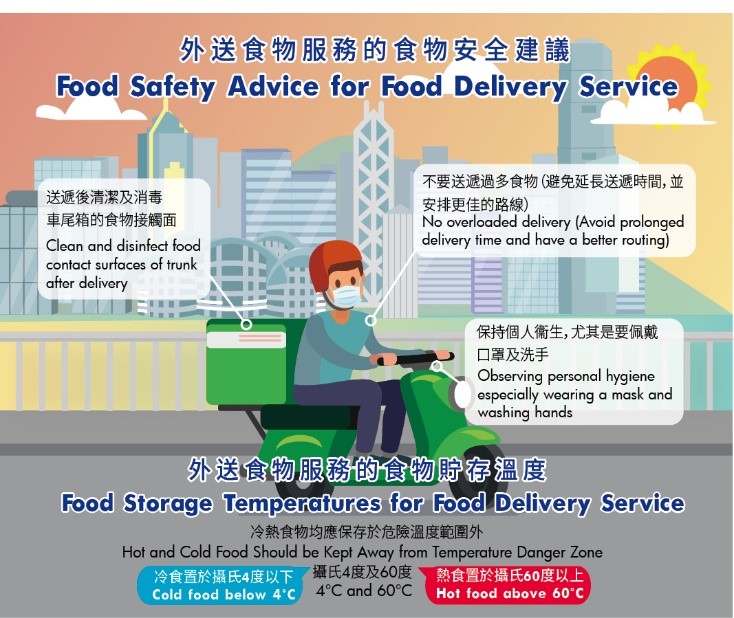
Figure 3: Proper hygienic practices and temperature control for food delivery
Food Safety Risks of Food Delivery from Restaurants
It is not uncommon for food operators to prepare food in advance to cater for a surge in demand during peak hours. Partially processed ingredients or cooked meal boxes will be set aside for some time before reheating and packing for delivery. The longer the time of food preparation and delivery and consumers’ deferred consumption, the higher the risk of the growth of food-poisoning bacteria in food within the temperature danger zone (between 4°C and 60°C). Besides, distorted and improperly sealed packaging, inadequate thermal insulation of food containers and unhygienic handling (such as food being tampered with by contaminated hands or altering the packaging) in the course of food delivery will also incur risks of cross-contamination of food.
Tips for Safe Food Delivery
While advanced food delivery mobile applications enable food caterers to take more orders from scattered locations, food caterers and delivery agents should pay heed to monitoring the hygienic practices of their staff during food storage and delivery. For the food delivery service, Hazard Analysis Critical Control Point (HACCP) plans or HACCP-based food safety systems are well-recognised and effective tools to systematically analyse and identify possible control points against different food hazards from food preparation, packing and storage to the final delivery. The risk control points should focus on food hygiene in food preparation, food temperature control and maintenance of cleanliness of all food contact surfaces during delivery.
Advice to Food Business Operators
Food handlers should adopt the Five Keys to Food Safety and implement the HACCP system, or follow its principles, to ensure food safety. These include the following:
- Food business operators should prepare food in a timely manner to match the delivery.
- The staff have to practise hand hygiene by washing hands before handling food for delivery.
- Use good heat-insulated delivery containers which are made of durable materials and fitted with tight lids.
- Designate a clean and dry place for storage of food packs prior to delivery.
- Do not put cold and hot food packs in the same bulk container to avoid undesirable temperature maintenance.
Advice to Food Delivery Service Providers
- Food delivery agents should ensure that hygienic means of transport is used and the food storage temperature is closely monitored to safeguard against cross-contamination of food.
- The service management should strictly control its delivery capacity by checking the time record against any delayed deliveries. Well-organised logistics can also shorten the food delivery time.
- Clean contact surfaces of delivery containers and motorcycle storage compartment (e.g. rear trunk or tail box case) thoroughly with sanitisers, disinfectants or liquid soap before and after each delivery.
- Store cold and hot food in separate insulated bags. Keep hot food at above 60°C and cold food at 4°C or below.
- Installing thermometers for recording temperatures in containers and food storage compartments is conducive to the implementation of food temperature control measures.
- Remind the staff to arrange food packs in an orderly manner to minimise food exposure to ambient temperatures due to unnecessary ransacking of food packs during delivery.
Updates on CFS
Food Safety Day: Eat Safe! Know Your High-risk Foods
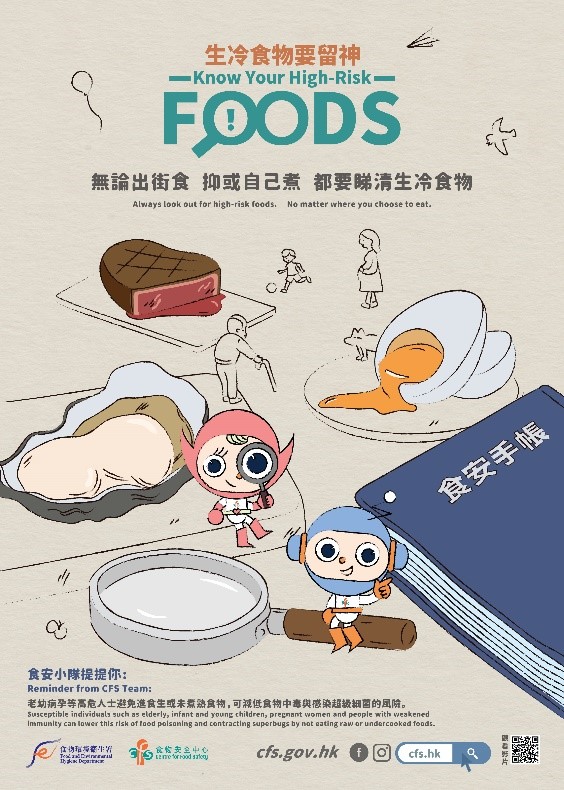
The CFS has adopted “Eat Safe! Know Your High-risk Foods” as the theme of Food Safety Day 2020. The aim is to draw public attention to the health risks of “raw and cold food” (a loose description of raw or undercooked foods) to four susceptible groups, namely pregnant women, infants and young children, the elderly and people with weakened immunity.
The health risks posed by “raw and cold food” to pregnant women and infants and young children were discussed in the previous issue. In this issue, we will focus on the elderly and people with weakened immunity.
The Elderly
Our body’s natural defences will become progressively weaker as we are getting old. Some elderly people may find their immune systems further weakened if they suffer from certain chronic diseases (e.g. diabetes) or are receiving treatment for such diseases.
People with Weakened Immunity
People with weakened immunity include those with immunological disorders (e.g. HIV infection) or chronic diseases (e.g. cancer) and patients undergoing immunosuppressive treatments (e.g. taking medicines to prevent transplant rejection). These people are more susceptible to food-borne diseases and their complications with the consumption of “raw and cold food”.
“Know Your High-risk Foods” Leaflets
- Food Safety Advice for Infants and Young Children
- Food Safety Advice for Pregnant Women
- Food Safety Advice for the Elderly
- Food Safety Advice for People with Weakened Immunity
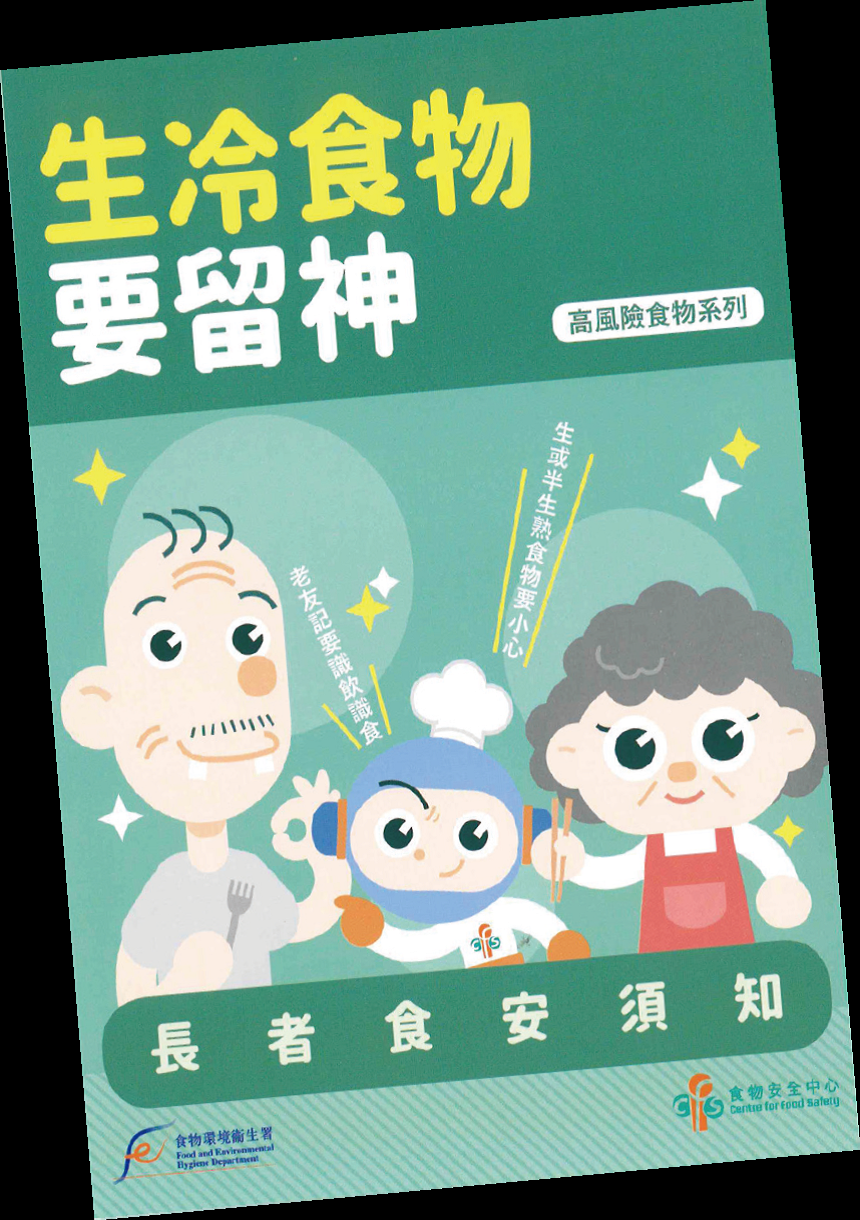

For more information, please visit the following webpage:
http://www.cfs.gov.hk/foodsafetyday/

Free copies of the leaflets are available at the Communication Resource Unit at Room 401, 4/F, Food and Environmental Hygiene Department Nam Cheong Offices and Vehicle Depot, 87 Yen Chow Street West, Sham Shui Po, Kowloon.
“EatSafe: CFS Channel” - A New Online Video Campaign on Food Safety
Food safety awareness is on the rise in Hong Kong. The number of food poisoning cases has hit new record lows in recent years. However, food poisoning incidents involving high-risk foods such as eggs and dishes not thoroughly cooked are still reported from time to time. These foods which pose the risk of cross-contamination are an underlying cause of food poisoning.
In view of this, we will launch a brand new online video campaign called “EatSafe: CFS Channel”. The CFS mascots, On and Mui, will hint at local movies to introduce some important food safety issues to the public in a humorous manner. Through the videos, the public will be able to gain practical food safety information through entertainment.
The “EatSafe: CFS Channel” will be unveiled on the CFS YouTube channel in January 2021 and co-streamed on the CFS Facebook and Instagram pages. Please show your support and share this series of videos with your family and friends.
Briefing of Activities
Food Safety Talks-Online Resources
Each year, the CFS organises food safety talks for the trade and the public at various locations across the territory. These talks were cancelled earlier this year due to the epidemic. As a corresponding measure, we have prepared videos on some food safety talks and uploaded them to the CFS website (https://www.cfs.gov.hk/tc_chi/multimedia/multimedia_vrt/index.html) for viewing by the public, anytime and anywhere.
The videos cover the following topics:
- 2020 Food Safety Talk Series on “Eat Safe! Know You High-risk Foods” (for the trade)
- 2020 Food Safety Talk Series on “Eat Safe! Know You High-risk Foods” (for the public)
- Seasonal Food Health Talk - Frozen Confections
- Seasonal Food Health Talk – Buffet Style Catering
- Seasonal Food Health Talk – Mooncakes
- Seasonal Food Health Talk – Rice Dumplings
- Seasonal Food Health Talk – Chinese New Year Festive Foods
- Seasonal Food Health Talk – Poon Choi
The safety talks have been resumed since October 2020. Members of the public are welcome to take part and learn the key principles of food safety.
Upcoming Activities
Public Consultation on Proposed Amendments to Harmful Substances in Food Regulations (Cap. 132AF)

The Government has been closely monitoring the international developments and measures relating to safeguarding of food safety, including making reference to the food safety standards of the Codex and other economies, as well as taking into account the local dietary practice and risk assessment results, to update the local food safety standards and regulatory arrangements on the basis of scientific evidence in a timely manner. To better protecting public health, the Government proposes to enhance and update the Harmful Substances in Food Regulations (Cap. 132AF) and will conduct a three-month public consultation on the proposed legislative amendments. Members of the trade and the public are welcome to express their views. Please browse the CFS webpage (www.cfs.gov.hk) for details.
Food Safety Q&A
Be Discerning When Ordering Delivered Foods Online
Truth Against Fallacy
Are Sweeteners the Only Way to Reduce Sugar Intake?
Sweeteners, generally known as sugar substitutes, are food additives used to enhance the sweet flavour of food. They are available as synthetic sweeteners and natural sweeteners of plant origins. In Hong Kong, all sweeteners approved for food use have been assessed by international institutions like the World Health Organization (WHO) as safe for consumption.
In the past, sweeteners or sugar substitutes would remind many people of persons with special dietary needs, such as the diabetes patients. As the public have become more health conscious, people with a sweet tooth are looking for healthier food options to delight the palate. To meet consumers’ demands, more food products are added with sweeteners. The common examples include various beverages and snack products such as candies and chewing gums.
Sweeteners are intensely sweet with very few or no calories. How sweet are they? Actually, they may be tens, hundreds or even thousands of times sweeter than the equal weight of granulated sugar! Therefore, only a tiny amount of sweetener is required to achieve the desired sweetness.
Earlier studies showed that artificial sweeteners might help reduce sugar intake, thereby facilitating short-term weight loss. However, some researches suggest that people using sweeteners may wrongly think that they have a lower calorie intake and become less conscious of the impacts of sugar. They may consume excessive amounts of foods and even crave for more sweet food, thus gaining weight and at a higher risk of developing illnesses.
The WHO recommends limiting sugar intake to less than 10% of the daily calorie intake, and proposes to lower this level to 5% or less for additional health benefits.
Both the public and the trade should reduce sugar in food by using less sugar and sweeteners. Consumers who wish to reduce sugar intake should refer to the labelling on the food packaging and choose food products with less sugar or no added sugar or sweeteners so as to adapt to a lighter flavour gradually.
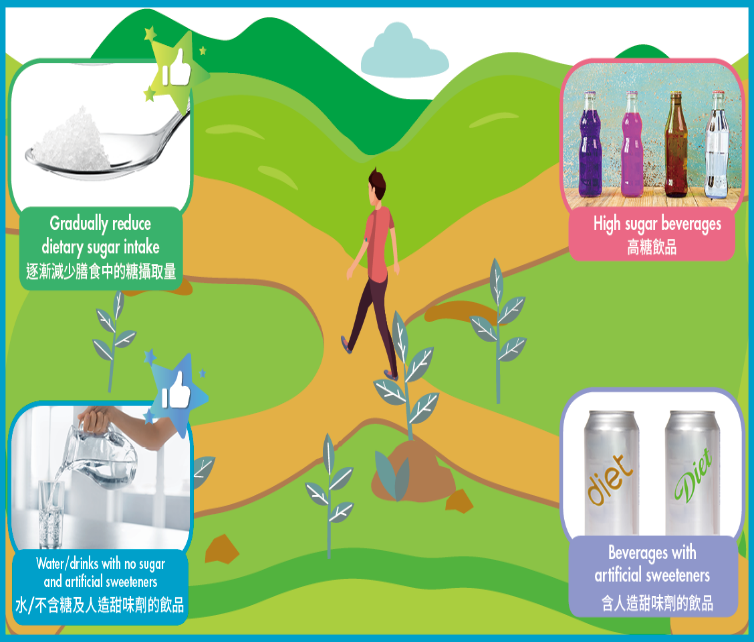
Your health is in your hands. Choose beverages with less or no sugar/ sweeteners.
Brain Gym
Multiple Choice Questions
-
Which of the following is the major cause of food poisoning in Hong Kong?
a. Physical hazards
b. Biological hazards
c. Chemical hazards
d. Radioactive hazards -
The nutrition labels of prepackaged foods contain information on energy and seven nutrients specified for labelling (1+7). Which of the following is not among the seven specified nutrients?
a. Protein
b. Sodium
c. Sugar
d. Vitamins - What is the recommended daily limit of sugar intake for an average adult?
a. 25g or about 5 cubes of table sugar
b. 40g or about 8 cubes of table sugar
c. 50g or about 10 cubes of table sugar
d. 75g or about 15 cubes of table sugar
Ans
- b
- d
- c
Enquiries and Subscription
Printed copies of the Food Safety Bulletin can be obtained from the Communication Resource Unit at Room 401, 4/F, Food and Environmental Hygiene Department Nam Cheong Offices and Vehicle Depot, 87 Yen Chow Street West, Sham Shui Po, Kowloon. For enquiries, please call 2381 6096.


